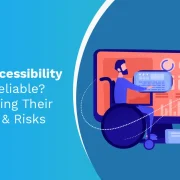
Best Practices in Continuous Integration and Continuous Deployment (CI/CD)
Today, companies ship their software in a matter of minutes. This reflects the pace at which the software industry is moving. This nimble environment which is not just swift but also reliable and secure has built on the concept of continuous integration and continuous deployment, also known as CI/CD. These concepts, if implemented correctly, can mitigate the challenges of manual labor requirements and consistency, enabling companies to deliver software to their customers at a hitherto unimaginable speed. Let’s take a look at what CI/CD is, the tools you can use to build it, and the best practices for its deployment.
Table of Contents:
- What is CI/CD?
- 5 Best CI/CD Tools That Developers Must Leverage
- Best Practices in CI/CD Deployment
- The Bottom Line
CI/CD
is a software development practice that enables you to release updates sustainably at any time. It comprises a combination of two practices – continuous integration and continuous deployment – and is most useful in environments that require fast, frequent, and meaningful changes in the code.
Continuous integration is the foundation of the CI/CD model. Using CI requires periodic changes to the main branch code several times a day as well as automated build and test sequences to support every code merger. This becomes essential as a developer gets no more than 10 minutes to complete the process for every code change. Once CI produces artifacts, these automated features verify that the code can be safely deployed.
At this stage, Continuous Delivery comes into play to deploy the code changes that are created. When the process of moving code from its source to production and then deploying it is fully automated, you have achieved Continuous Deployment.Speed and quality have emerged as the backbone of agile DevOps methodologies. You need the right tools to get optimal results in your continuous integration and continuous deployment process. Here are five such top-of-the-line tools
that developers must leverage:
1. Jenkins
Jenkins is an open-source server that supports automation in the building and deployment of software. It is a Java-based program that is compatible with software designed for operating systems such as MacOS, Windows as well as Unix. It stands out for:
- Ease of installation and upgrade
- User-friendly interface
- Master/slave architecture to support distributed builds
- A plugin resource enriched by extensive community contributions
2. Bamboo
This integration server automates the process of releasing software applications, enabling a robust continuous integration and continuous deployment pipeline. Some of its USPs include:
- Support for 100 remote building agents
- Running automated parallel test batches
- Quick feedback
- Triggering builds based on the latest changes in the software repository
3. CircleCI
This is a CI/CD tool that stands out for its ability to support rapid development and publishing for a wide range of software applications. It can be integrated with other popular tools to create builds for new code lines. Its key highlights are:
- Cloud-managed services
- High scope for customization
- Parallel automation
- Fast setup with unlimited build support
4. TeamCity
This building management and CI server help in building and deploying a vast range of projects. It is also compatible with all popular operating systems and supports both open-stack and .NET applications. TeamCity stands out for the following:
- Scope to reuse configurations and settings from a parent project for its related applications
- Running parallel builds in diverse environments
- Ease of customization
- Adding stability to CI/CD server functionalities
5. GitLab
GitLab comprises a suite of tools that enable swift management of different aspects of software development and deployment lifecycle. At its core, GitLab is a web-based manager for software repositories equipped with functionalities such as analytics and tracking. Its standout features include:
- Using branching tools to create, view and manage codes for different projects
- Scalability for managing different codes and projects
- Use of extensive automation to shorten release and delivery timelines substantially
- The ability to manage building, testing, and deployment of code with a single tool
With nearly 50% of enterprises embracing DevOps in their IT operations, continuous integration and continuous deployment are fast becoming the norm. To be able to leverage this process to its optimum potential, you need to focus on institutionalizing the right practices.
Here are some of the best CI/CD deployment practices to focus on:
1. Put Security First
Vulnerabilities in your IT infrastructure can lead to massive financial losses and expose your business to the risk of a dented reputation. Since continuous integration and continuous deployment opens your codebase to wider access to enable deployment in diverse environments, safeguarding your credentials from hackers should remain a top priority. Isolating the CI/CD systems from the rest of your tech infrastructure and hosting them on secure internal networks can do the trick.
Also Read: Cloud Security Best Practices
2. Assess Organizational Preparedness
Wanting to leverage the latest trends is all very well, but your efforts can fall flat if your organizational structure is not prepared to support this transition. For effective CI/CD deployment, building a microservices architecture is the most reliable move. Instead of a total overhaul of your existing tech architecture in one go, consider a more incremental approach. Focus on the maintenance of critical systems and then build a new architecture around them.
3. Adopt a Build Once Policy
Commit to building source codes only once by eliminating any practices that run the risk of duplicity. Even in the case of building, packaging, or bundling new software, rely on binaries to ensure that each step gets executed only once. Maintaining a clean environment is essential for swift, hassle-free CI/CD implementation and operation.
4. Prioritize Automation
Automation lies at the core of successful – continuous integration and continuous deployment. However, going overboard with automating build and test processes can prove counterproductive. Take the transition from manual processes to automation one step at a time and decide which processes to overhaul first.
5. Release & On-Demand Testing
The software applications must be tested in an operational environment to keep them release-ready as frequently as possible. To achieve this, you must focus on creating a deployment environment that closely resembles a production-like setting. Besides, you should also consider running on-demand tests in containers to reduce the risk of a product behaving differently in real and development environments. The continuous integration and continuous deployment process hold immense potential in revolutionizing software building, testing, and deployment routines as long as you work with the right resources in the right environment.
Hurix Digital helps you with your CI/DC needs. Get in touch with us today.
Suggested Reads:
- Cloud Cost Management – All You Need to Know About Cloud Cost Management
- Cloud Cost Optimization: 6 Best Practices for Cloud Cost Optimization




